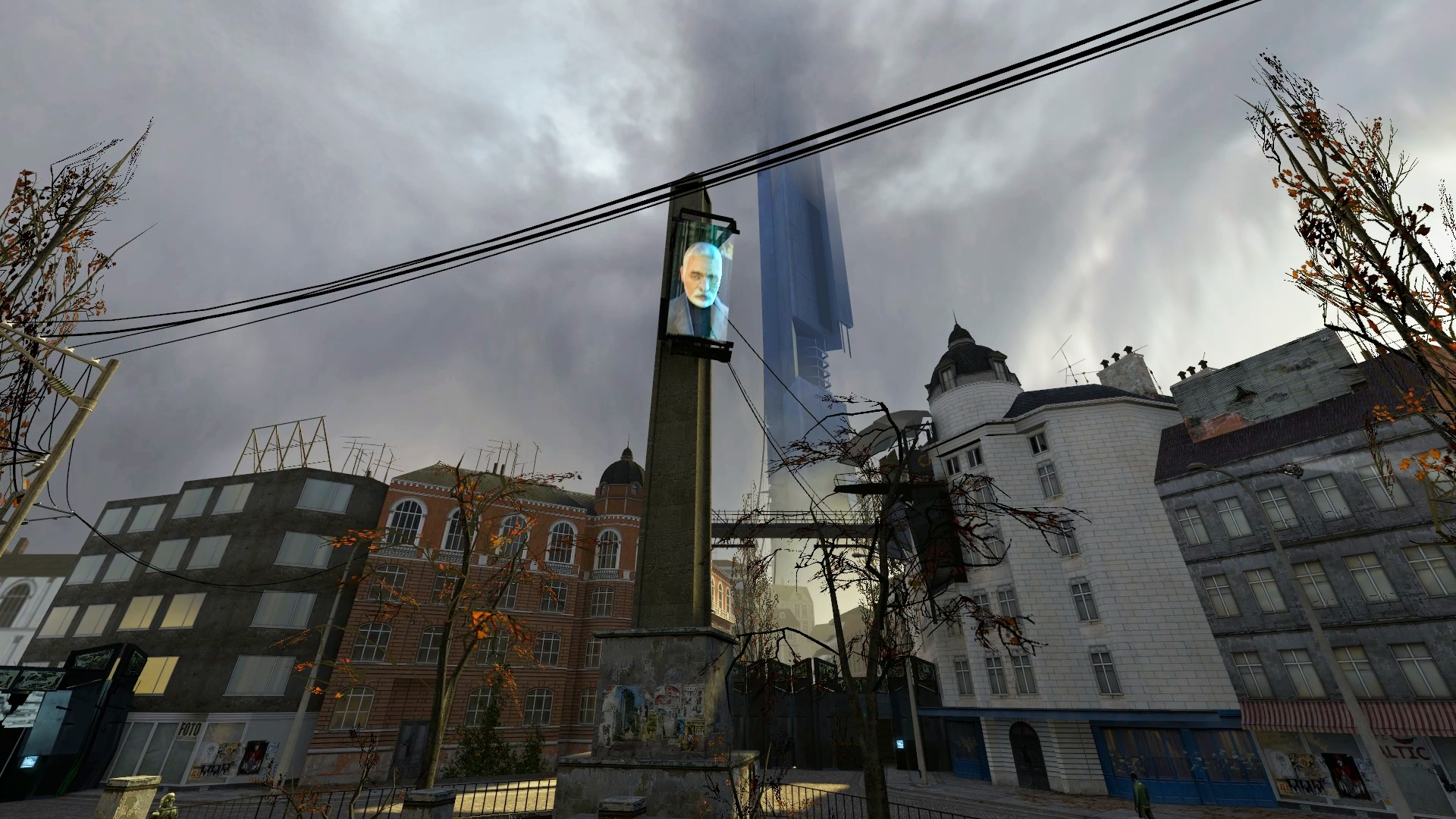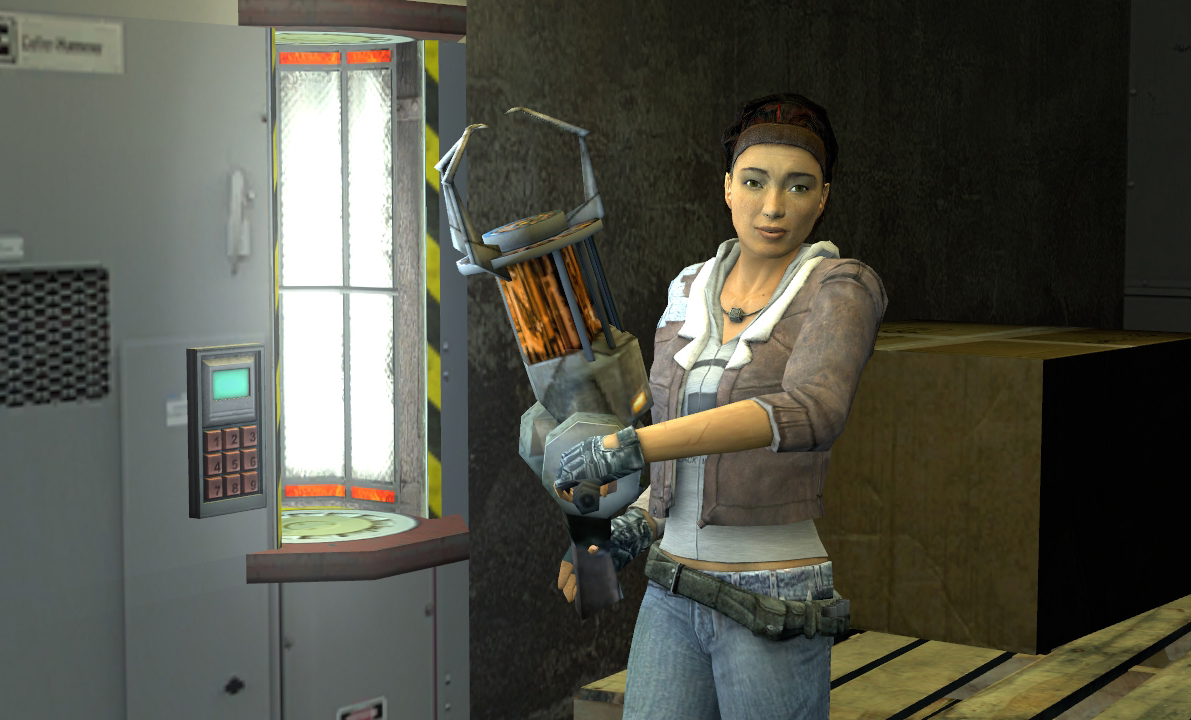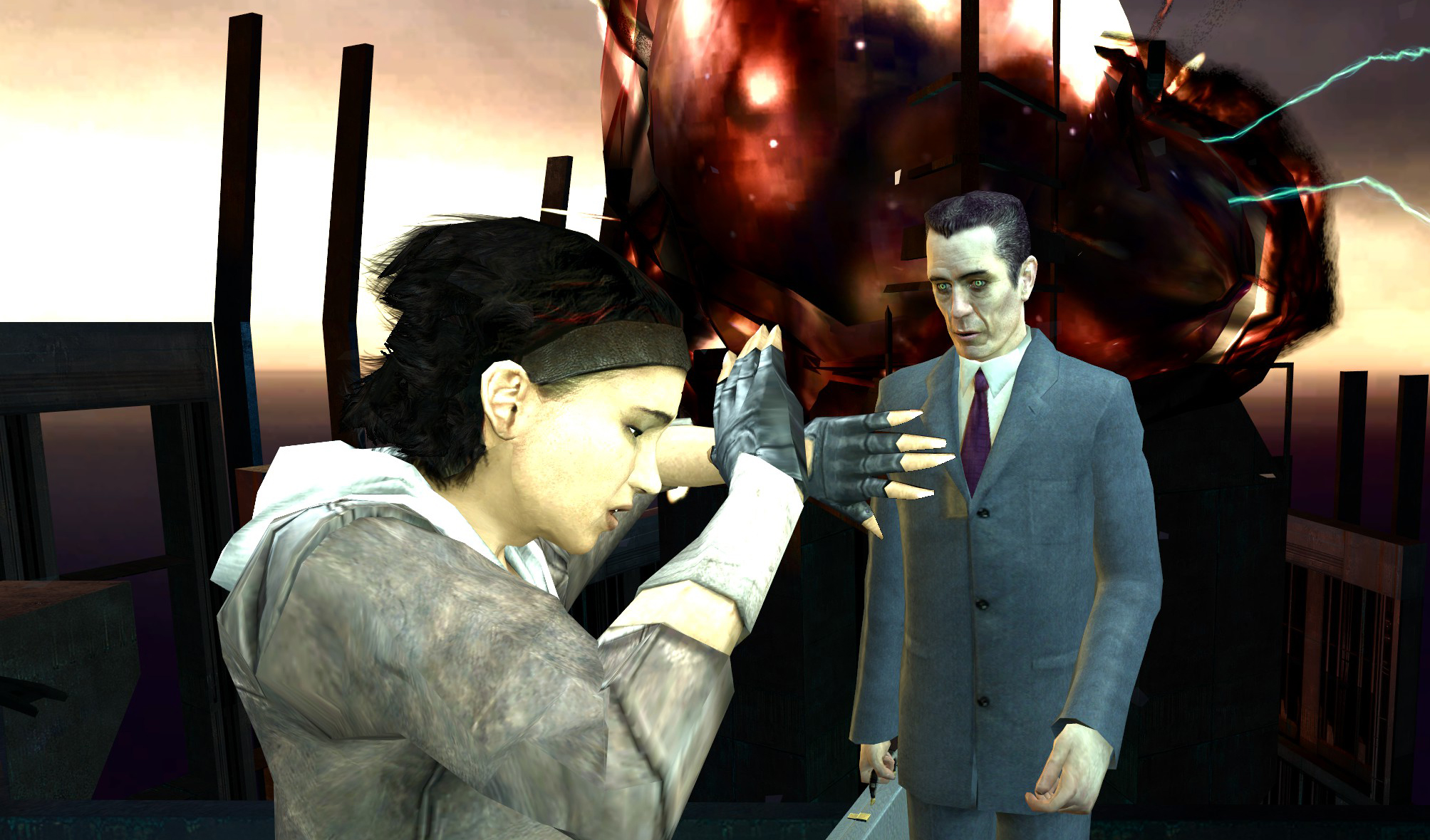Meet the minds behind Half-Life 2
What does it take to make the greatest game of our time?

So now you have the script. What happens next?
ML: The script represents things we want to accomplish with the story, and the stuff that the animators, that Bill, wants to get across and spend time animating. This is really abstract, but while this level is being built, we have to roll it out. We have this problem of making a scene come about in a space in the game. That’s pure choreography.
BVB: We actually have a choreography team, that’s what we call them internally, who deal with a character’s audio, animation, acting and scene design. A feature of the way we work is that the scene is constantly coming into focus. We have such an adaptive process, some of it is even collage-like. The more information you get into it, whether it’s the script, the acting sessions, the effects or the animation, the better it is.
We’ll have very good character profiles that inform the script, then some people will take that and bang on it. Marc takes their suggestions and rolls them in, then we’ll go back and do a recording session. The actors then bring in a whole new different level of intelligence and interpretation to the stuff that has been written. With some direction, knowing how it’s supposed to be played in the game, we’ll come back and put it in the level. Then, even more changes happen... “This is too long, we can’t fit it here. We can’t afford this line... but, this line the person did was a much better take, we didn’t realise that in the studio.
Sometimes even lines come up that were accidents, they weren’t even intended to be used... They’re so well said that we grab them and put them into the scenes. Bill, driving the animation/visualisation, knows what he wants to do with them in terms of body language... so that takes it again to another level.
How do your voice actors react to giving ‘game’ performances. Are you after something different from what they’re used to?
ML: I think it’s probably like radio. It all has to be there in the voice. We do a bunch of alternate takes – “give me this performance as if you’re right next to me. Now do it like you’re 20 feet across the street.” One of the things they provide is a range of experiences that we can get back here to see what works. We can do mix and match... It’s not like we go into the studio and get the fullblown radio-play version of the thing. We have to bring it back here and cook it for a while. It’s like the mad scientist in the laboratory. We put all these performances into a pot, some of them bubble away, some of them explode, some of them do something you don’t really expect.
The biggest gaming news, reviews and hardware deals
Keep up to date with the most important stories and the best deals, as picked by the PC Gamer team.
Bill Fletcher: We might be having a quiet, whispered line, but we need it to be heard from across the street, or right up close. We need the same line, but different projections. We look for a different type of voice than other people. We’re not after ‘voice talent’, we want actors. We’re not looking for a funny voice, or a sexy voice, we’re looking for someone who adds character behind the voice, to create someone that you believe in.
BVB: We’ve worked with some of the Half-Life guys before, like Mike Shapiro, and Al Robbins, who did Barney, Dr Kleiner, and the G-Man. But I think in general, we found that it was great at the beginning of the sessions, and each successive take continued to get better. We brought some knowledge about who the characters were, and what was happening in the game, they brought this great wealth of acting experience. It was a flexible, open partnership. We’d have different ideas and make suggestions, they’d do the same. For them, I think it was a great leap of faith. They didn’t have the other person who they were acting with there, they were in isolation, and most of them didn’t have much experience of games at all.

The moment that really stood out for me was when Alyx passes through the teleporter. You see her on the monitor: when she arrives, she gives Eli a little peck on the cheek. I’ve never seen that in a game... it just nails the relationship, and perfectly sets up the later jeopardy. I don’t think I’d ever seen such a kiss like that in a game before.
ML: That was when the scene really came to fruition. It wasn’t in the script. It was implicit in their relationship, but that visual language is not... like... I’ll do everything I can with the words, but I’m finding that we can actually cut lines because the acting and animation supports silence. That’s what I’m shooting for, to get stuff into the animators’ hands that lets them go even further. We know there’s affection between them, we build it up like scaffolding, but when you’re on top of that... A lot of the animation seems to be the extra one percent that tips it over. In that scene, the kiss seems really simple. Even to me, it came out of the meaning of the scene.
It sounds almost like you improvise the final touches. Is that fair? Is there room to improvise?
BF: Not really. It’s impossible to improvise because of the sheer amount of planning that has to go in. Every movement needs so much work.
ML: You know, it seems like improv to me, when I see it. It feels like the little nugget that we’re working toward the whole time. You’re not quite sure what you’re going to do, or how you’re going to pull it off, until all the pieces are in place. You don’t really know what you’re going to work with.
BF: One thing I’m always conscious of, is that Marc handles all the dialogue, storytelling, and all that but I’m thinking “what can I do with that dialogue”, or “what can I do between the dialogue”. I’ll look at each scene and say “OK, there’s got to be a couple of moments here that I have to create. The kiss was something I was thinking about, but didn’t put in until the very end. I knew we had to put in this physical contact between Eli and Alyx. The first time I went through the scene, I couldn’t get it quite the way I wanted. Toward the end of the project, I came back to it, and worked on it again. It seems a lot of people had exactly the same reaction you’re talking about.
You seem to embed a lot of details about characters into their bodies, not just in the writing or dialogue. Like, for instance, the way Alyx wears a battered old Black Mesa hoody.
BVB: When we start creating characters we have ‘character profiles’. Instead of designing them totally from drawings, we cast faces. We’ll look at photos, find people who we think would look like the character. That would draw them into focus. We’d make sketches about what their body types are... Alyx had a sketch before we cast the face, then we ran a big casting process for the voice, which again helped inform us about her as well.
ML: Really, it’s just a bunch of individuals thinking about the hard problems. The people that think the hardest about those are the artists – they’re the ones who came up with the Black Mesa hoody. It comes from being immersed in the world, wanting to do it right. I love it when stuff like that gets thrown up, though, because it’s recognition that we’re all inhabiting the same world. It’s almost like we were all at Black Mesa together, that we recognised that she would have a Black Mesa hoody. The level designers have that level of inventiveness, too, the same level of creativity when they’re working with their tools – you see each person’s contribution as “what’s the coolest thing I could do with the little piece I’m working on”.

When you’re working on a scene, do you use pre-visualisations? Do you storyboard? Lamar beating up Barney, for instance, must have needed a lot of preparation.
BF: We probably should use storyboard. Yeah.
BVB: Yeah. [laughing] That would really help.
BF: It’s just brainstorming, really. Then we just block it in, a bare-bones scene. It’s just characters walking around, hitting their marks, saying their lines, then walking off again. Then we slowly start adding things...
ML: The Lemar sequence started as a little idea in the script. We have a lot of those off-the-wall moments. When I bring them up, mostly people will just go “pfah,”, or they get this little look in their eyes, and they’ll start to do it. My instinct is, if no-one has any really strong misgivings about an idea, I’ll pursue it, until people finally accept it. I think the Lemar sequence happened that way. I had a crazy idea “What if Dr Kleiner had a pet headcrab?” It just seems like a silly idea, but if you keep repeating it and repeating it, when people start working on it, they buy into it. It would just never occur to them that he wouldn’t have a pet headcrab.
That would happen time and again: the little thing that you thought was crazy actually gets people excited. We’re not just building the game because you have to go from point A to point B. We’re building it because there’s fun little things you get to do on the way. The details, the non-essential stuff, is actually half the fun. Things we think would be cool, but we wouldn’t put them on the box. That’s the kind of thing I look for in a game. What’s the extra bit they did, that they didn’t have to do. That’s when you really see the personality behind the whole thing.
It’s like the mad scientist in his laboratory...
Marc Laidlaw
It sounds like you really enjoy what you’re doing.
ML: We’re having lots of fun doing this. If I were working on a Star Wars game, there’d be a bunch of in-jokes we could do, but it wouldn’t be as if you were creating the universe as you did them. You don’t get that creative buzz where we’re not just making jokes; we’re actually suggesting things about the world itself. I think that other games are kind of constrained in their inspiration because they’re given a story-Bible. Everyone here knows that if they have an idea that doesn’t quite fit the world, we can sit down and talk about it and adjust the world to make it work.
BVB: There’s a certain amount of empowerment that people here have. You’ve already heard the huge amount of influence everyone has over each part of the game. It’s not one person driving their vision. Do you remember coming down into Eli’s lab, seeing the Vortigaunt chefs? That’s an idea Dhabih Eng [One of Valve’s Senior Artists] had. That wouldn’t have made it into the game at any other company. It’s silly, our game’s supposed to be a scary game, but somehow, we have Vortigaunts in chef hats.
ML: Dhabih did the most amazing models you’ve never seen. We were watching him building this stuff, putting so much detail into something no one will ever see. But he’s so excited to be doing it. Even like a curmudgeon would look at it, and say “Normally, I’d say we shouldn’t be doing this. But this is so cool we have to keep it in the game.” Then we try not to draw attention to it, we just leave it there for people to discover.

